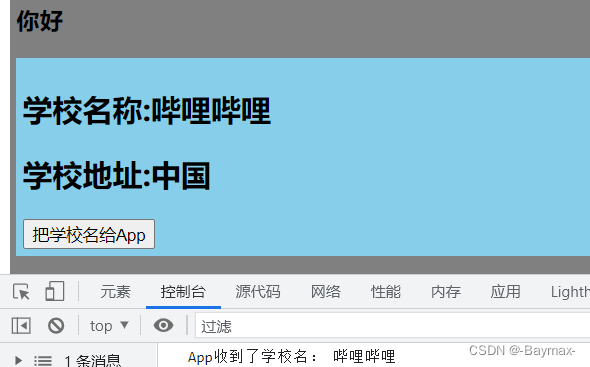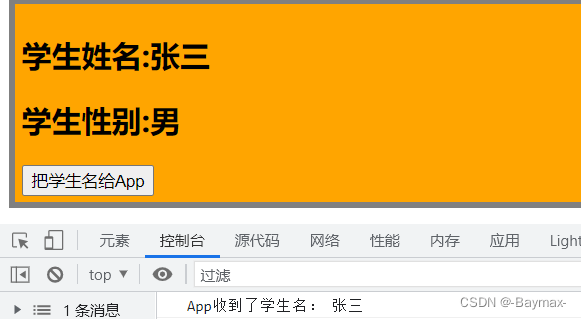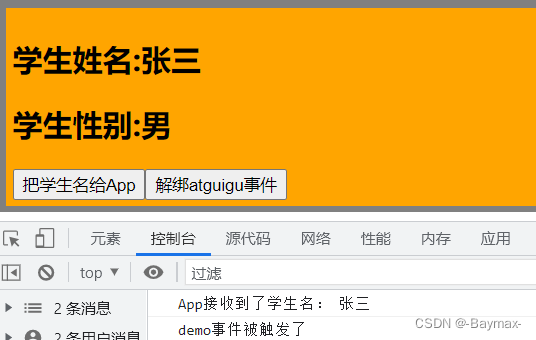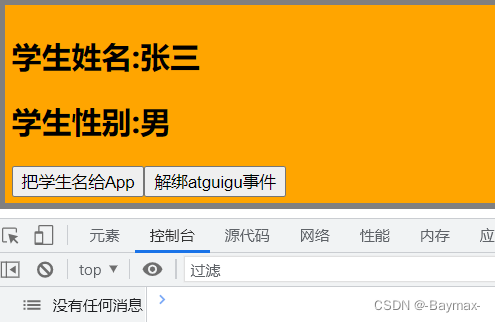文章目录
一、组件自定义事件_绑定
1. props 实现(复习)
通过父组件给子组件传递函数类型的 props 实现:子给父传递数据
- 在父组件
App.vue中定义getSchoolName()用来接收从子组件传过来的值。- 在子组件
School.vue中定义props: ['getSchoolName'],接收父组件给子组件传递函数。- 在子组件
School.vue的 methods 方法中把值传给父组件。
School.vue
<template>
<div class="demo2">
<h2>学校名称:{
{
name }}</h2>
<h2>学校地址:{
{
address }}</h2>
<button @click="sendSchoolName">把学校名给App</button>
</div>
</template>
<script>
export default {
name: "SchoolName",
props: ["getSchoolName"],
data() {
return {
name: "哔哩哔哩",
address: "中国",
};
},
methods: {
sendSchoolName() {
this.getSchoolName(this.name);
},
},
};
</script>
App.vue
<template>
<div class="demo">
<h3>{
{
msg }}</h3>
<!-- 通过父组件给子组件传递函数类型的props实现:子给父传递数据 -->
<School :getSchoolName="getSchoolName" />
</div>
</template>
<script>
// 引入组件
import School from "./components/School.vue";
import Student from "./components/Student.vue";
export default {
name: "App",
components: {
School, Student },
data() {
return {
msg: "你好",
};
},
methods: {
getSchoolName(name) {
console.log("App收到了学校名:", name);
}
}
};
</script>

2. 自定义事件实现(使用 @)
通过父组件给子组件绑定一个自定义事件实现:子给父传递数据
(使用@)
- 在父组件
App.vue中自定义事件@atguigu绑定到Student组件上。- 在子组件
Student.vue中通过this.$emit("atguigu", xxx)触发该事件。- 可以传参,在
App组件中可以以形参的方式(...params)接收并输出。
Student.vue
<template>
<div class="demo1">
<h2>学生姓名:{
{
name }}</h2>
<h2>学生性别:{
{
sex }}</h2>
<button @click="sendStudentName">把学生名给App</button>
</div>
</template>
<script>
export default {
name: "StudentName",
data() {
return {
name: "张三",
sex: "男",
};
},
methods: {
sendStudentName() {
// 触发Student组件实例上的atguigu事件
this.$emit("atguigu", this.name, 666);
},
},
};
</script>
App.vue
<template>
<div class="demo">
<h3>{
{
msg }}</h3>
<!-- 通过父组件给子组件绑定一个自定义事件实现:子给父传递数据 (第一种写法:使用@)-->
<Student @atguigu="getStudentName"/>
</template>
<script>
import School from "./components/School.vue";
import Student from "./components/Student.vue";
export default {
name: "App",
components: {
School, Student },
data() {
return {
msg: "你好",
};
},
methods: {
getStudentName(name, ...params) {
console.log("App收到了学生名:", name, params);
}
}
};
</script>

3. 自定义事件实现(使用 ref)
通过父组件给子组件绑定一个自定义事件实现:子给父传递数据
(使用ref)。
- 在
Student标签中通过ref = student给组件注册引用信息(相当于 id 的替代者)。- 在钩子函数中,通过
this.$refs.student.$on('atguigu', xxx)绑定自定义事件。(ref 打标识,$refs 获取)vm.$on(event, callback)用于监听当前实例上的自定义事件,事件可以由vm.$emit触发。- 如果把
$on改成$once则只触发一次。- 可以给添加
setTimeout()执行异步任务。
Student.vue 不变
App.vue
<template>
<div class="demo">
<h3>{
{
msg }}</h3>
<!-- 通过父组件给子组件绑定一个自定义事件实现:子给父传递数据 (第二种写法:使用ref)-->
<Student ref="student" />
</div>
</template>
<script>
import School from "./components/School.vue";
import Student from "./components/Student.vue";
export default {
name: "App",
components: {
School, Student },
data() {
return {
msg: "你好",
};
},
methods: {
getStudentName(name){
console.log('App收到了学生名:', name);
}
},
mounted() {
this.$refs.student.$on("atguigu", this.getStudentName); //绑定自定义事件
// this.$refs.student.$once("atguigu", this.getStudentName); //绑定自定义事件(一次性)
},
};

3s 后触发绑定的自定义事件(三秒之后点击才会输出内容)
setTimeout(() => {
this.$refs.student.$on('atguigu', this.getStudentName)
}, 3000)
二、组件自定义事件_解绑
1. 解绑一个 / 多个自定义事件
语法:
this.$off('xxx')
语法:
this.$off(['xxx', 'xx'])
<template>
<div class="demo1">
<h2>学生姓名:{
{
name }}</h2>
<h2>学生性别:{
{
sex }}</h2>
<button @click="sendStudentName">把学生名给App</button>
<button @click="unbind">解绑atguigu事件</button>
</div>
</template>
<script>
export default {
name: "StudentName",
data() {
return {
name: "张三",
sex: "男",
};
},
methods: {
sendStudentName(){
this.$emit('atguigu', this.name)
},
unbind(){
this.$off('atguigu') //解绑一个自定义事件
this.$off(['atguigu','demo']) //解绑多个自定义事件
}
}
};
<template>
<div class="demo">
<h3>{
{
msg }}</h3>
<Student @atguigu="getStudentName" @demo="m1" />
</div>
</template>
<script>
// 引入组件
import School from "./components/School.vue";
import Student from "./components/Student.vue";
export default {
name: "App",
components: {
School, Student },
data() {
return {
msg: "你好",
};
},
methods: {
getStudentName(name) {
console.log("App接收到了学生名:", name);
},
m1() {
console.log("demo事件被触发了");
},
}
};
</script>
点击把学生名给 App

点击解绑 atguigu 事件后再点击把学生名给 App

三、总结 — 组件的自定义事件
1. 组件自定义事件是什么?
一种组件间通信的方式,适用于:子组件 => 父组件
2. 使用场景
A 是父组件,B 是子组件,B 想给 A 穿数据,那么就要在 A 中给 B 绑定自定义事件(
事件的回调在 A 中)。
3. 绑定自定义事件(两种方式)
- 第一种方式,在父组件中
<Demo @atguigu="test" />
//或者
<Demo v-on:atguigu="test" />
- 第二种方式,在父组件中
<Demo ref="demo" />
...
mounted() {
this.$refs.demo.$on("atguigu", this.test)
}
若想让自定义事件只能触发一次,可以使用
once修饰符,或$once方法
4. 触发自定义事件
this.$emit('atguigu', 数据)
5. 解绑自定义事件
this.$off('atguigu') //解绑一个自定义事件
this.$off(['atguigu', 'demo']) //解绑多个自定义事件
6. 如何在组件上绑定原生的DOM事件
组件上也可以绑定原生DOM事件,需要使用
native修饰符
如果不加native则会被认为是自定义事件
<Demo @click.native='test' />
7. 注意事项
在通过
this.$refs.xxx.$on('atguigu', 回调)绑定自定义事件中,回调要么配置在 methods 中,要么用箭头函数,否则 this 指向会出问题。
不积跬步无以至千里 不积小流无以成江海